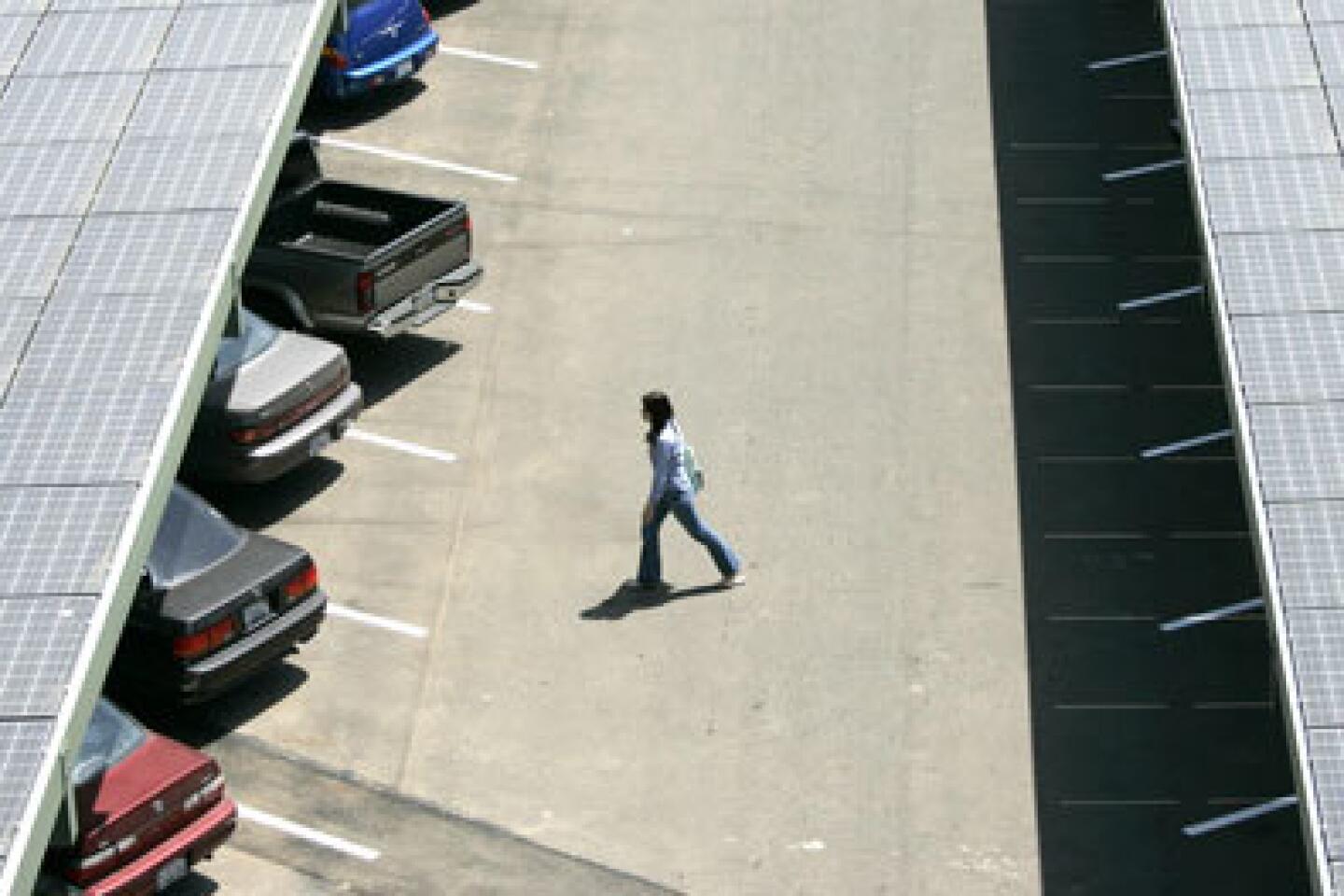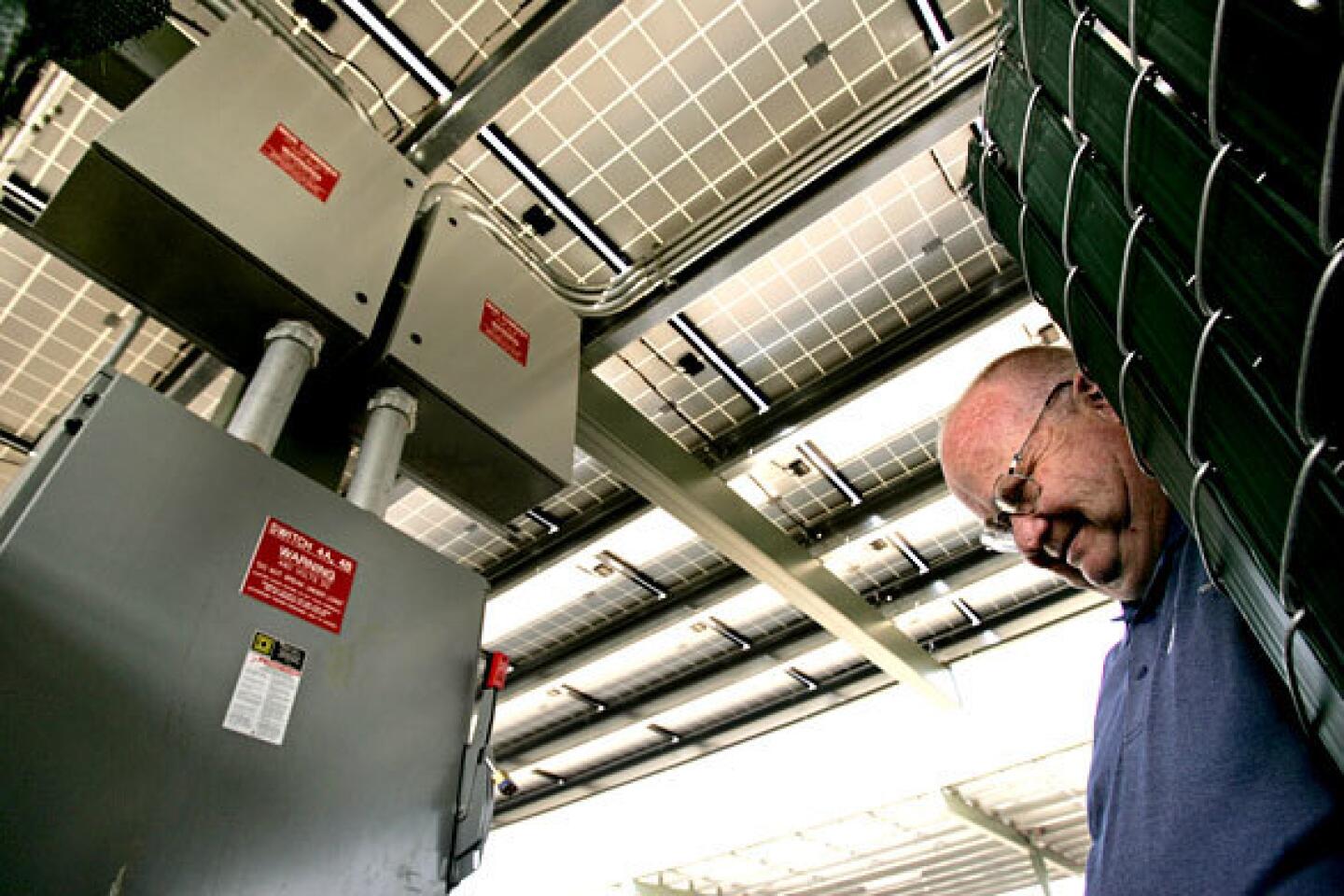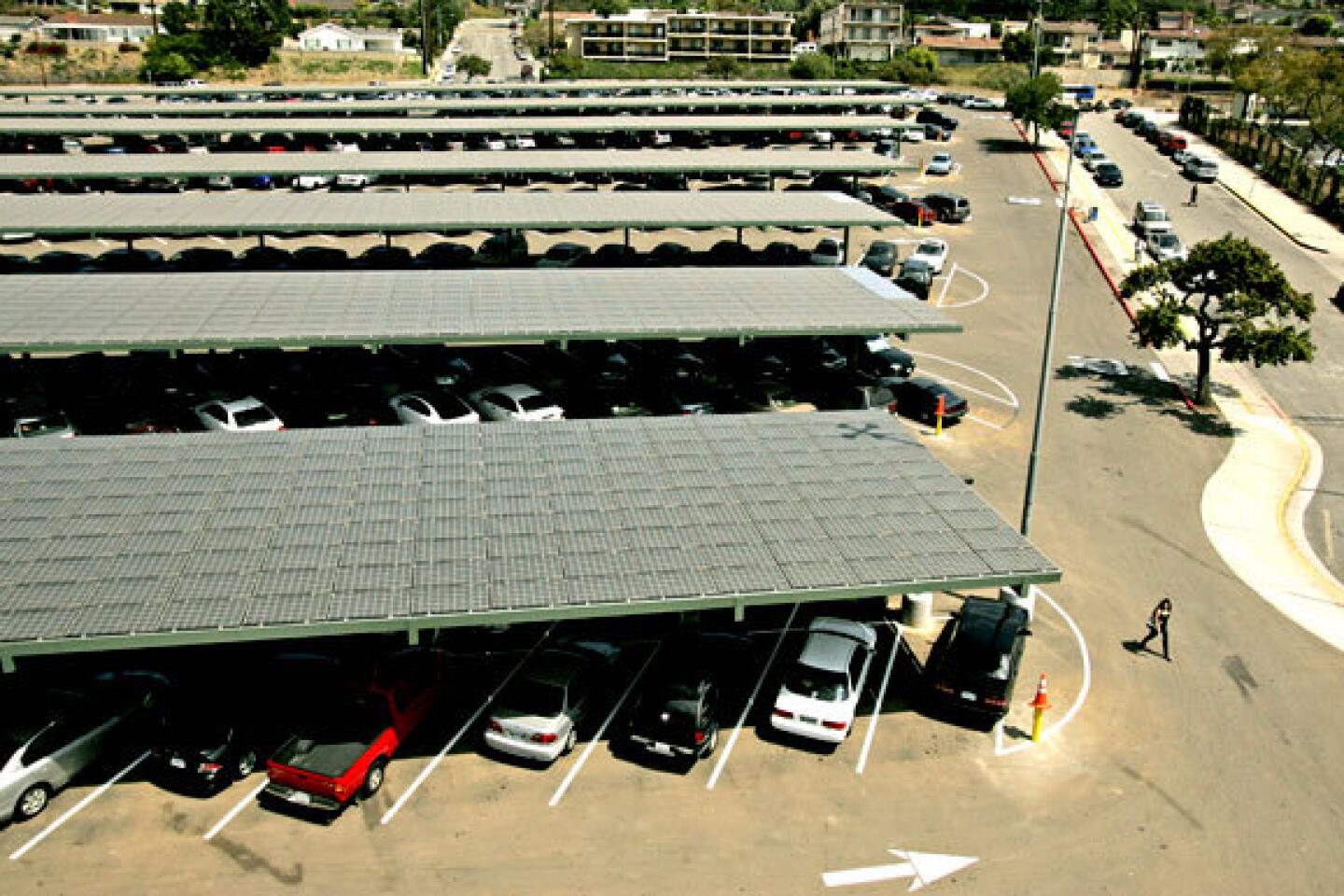Colleges, universities take the lead in building green
- Share via
There’s a green sheen settling over colleges and universities.
This spring, East Los Angeles College unveiled 5,952 solar panels that generate nearly half of the college’s energy.
At Santa Clara University, one building has carpet tiles made of yarn and the entire floor is raised on 14-inch legs so that air circulating below can warm or cool classroom floors. A glass “solar chimney” aids ventilation.
At Santiago Canyon College in Orange County, the library is cooled by vertical perforated solar fins. A building at Stanford University is built partly of redwood salvaged from century-old wine vats.
And in Iowa, geothermal wells drilled 120 feet below the parking lot at Grinnell College’s Conrad Environmental Research Area help heat and cool the buildings.
Experts who follow building trends agree that in the last decade, as fears of global warming grew and examples of eco-innovation spread online, campus greening morphed from a fad into mainstream phenomenon.
The array of solar panels at East Los Angeles College is expected to last at least 40 years and is producing about 45% of the college’s energy, or 1.9 million kilowatts annually, for a yearly savings of $270,000.
The panels are suspended over 530 spaces at a campus parking lot, opposite a baseball field carpeted in artificial grass to save water.
The Los Angeles Community College District, which includes East Los Angeles, is undergoing one of the largest green building efforts in the country’s public sector, with more than 40 buildings planned and all facilities set to employ only renewable energy.
“At the time it was a risky venture. People thought we were throwing money away,” said Sylvia Scott-Hayes, president of the district’s board. “We wanted to make a statement, set an example for students.”
Scott-Hayes said the district struggled to find architects and engineers fluent in eco-friendly techniques when it started its effort in 2003. Now, green consultants do brisk business.
At the 10 University of California campuses, a 2004 policy mandating that all new or renovated buildings be eco-friendly has saved the system nearly $5 million, officials say.
Conventional buildings account for 36% of the country’s total greenhouse gas emissions and 39% of its total carbon dioxide emissions, according to the U.S. Green Building Council. They also consume 71% of its electricity and 3 billion tons annually -- or 40% -- of the world’s raw materials. Sustainable facilities significantly lower those percentages.
“It’s been small, early changes leveraging larger changes, and faster than anticipated,” said Judy Walton, acting executive director of the Assn. for the Advancement of Sustainability in Higher Education. “It’s transformed the way we build buildings.”
For the first time, green-building guidelines are de rigueur on many campuses, and some student bodies have voted to raise fees to pay for construction.
Several states have passed measures, such as Title 24 in California, requiring structures built with public funds to be eco-friendly.
Glenn Carels, a designer with the firm LPA Inc., said schools have plenty of incentive to build sustainably. He calls it the “triple bottom line” of planet, people and profit.
Many college officials say they have a social responsibility as institutions of learning to use buildings as publicity for green alternatives.
That eco-friendly buildings shrink costs is especially helpful during a time of budget cuts for education. Despite the initial “green premium” -- the extra cost of building to green standards -- sustainable facilities tend to have fewer operating expenses. And according to a study done in conjunction with the American Institute of Architects, eco-friendly construction helps lower absenteeism, improves productivity and staves off health problems for students and teachers.
Going green can also boost student recruitment.
At Mills College in Oakland, the new Natural Sciences building is 90% more energy-efficient than most Bay Area laboratories. After prospective students received letters and tours highlighting the building, applications noting interest in environment and science studies spiked, said Giulietta Aquino, dean of undergraduate admissions.
And ever since Warren Wilson College’s EcoDorm opened in North Carolina in 2004, featuring a converted railroad tank car that funnels storm water through the building, students have jostled for spots.
As the trend grows, so do the ways schools can measure progress. The Assn. for the Advancement of Sustainability in Higher Education is developing a system to judge campuswide sustainability, based on the country’s most prominent rating system, the Green Building Council’s certification in Leadership in Energy and Environmental Design, known as LEED.
In 2001, there were 42 LEED projects in the higher education sector. Between 2006 and 2007, the number nearly doubled from 769 to 1,412. As of June, 1,497 buildings were seeking certification.
The walls in the highest-rated school facility -- the Applied Research and Development facility at Northern Arizona University -- are insulated by thousands of pairs of recycled denim jeans.
Buildings at other schools sit on frames of recycled metal from cars, have countertops made of crushed traffic lights or furniture made of recycled milk jugs.
But experts warn against launching green projects -- or “painting green” -- just to impress and attract students. The experts also warn against gimmicks.
For example, a building that faces the sun and maximizes daylight has a more lasting effect than power outlets for electric vehicles, said Carels, the designer. A low-maintenance and flexible building frame can last 100 years.
“There’s a tendency to be gimmicky because it has a wider general appeal,” Carels said. “Schools don’t always look at both the bigger as well as the micro scale.”
Still, designers have unleashed a variety of techniques to conserve energy or prevent pollution.
To generate power naturally, some campuses have erected windmills.
Some “dark sky” campuses attempt to limit nighttime light pollution.
At the Yale Sculpture Building, a translucent curtain made of Nanogel -- a material known as “frozen smoke” that is 95% air -- maintains the temperature while letting natural light in.
Then there’s the University of Michigan’s Dana Building. In 2003, the university forked out $17 million to renovate the structure into one of the country’s premier eco-friendly buildings.
The air is warmed through a sunroof and cooled by water in copper pipes. Light fixtures, all fluorescent, are powered mostly by a solar array and an on-campus power plant.
Floors are partly made of tire rubber and countertops are packed with wheat, sunflower seeds, soy flour and newspaper. The bricks from demolition were stored for future use.
And don’t forget the restrooms. Low-flow, sensor-activated faucets and toilets that compost human waste into fertilizer help lower water use in rooms tiled with glass from airplane windshields.
More to Read
Sign up for Essential California
The most important California stories and recommendations in your inbox every morning.
You may occasionally receive promotional content from the Los Angeles Times.















